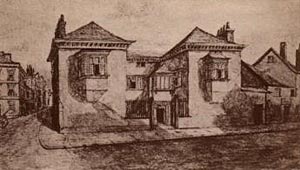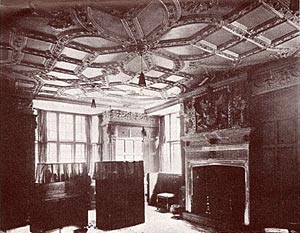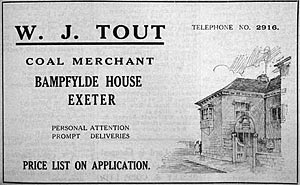
- Home
- Memories
- Scrapbook ▽
- Topics ▽
- People ▽
- Events
- Photos
- Site Map
- Timeline
Page updated 5 December 2008
This house was the town house of the Bampfylde family and was the third big loss to Exeter during the May 1942 blitz, in what is now known as Princesshay, the other losses being St John's Hospital School and Bedford Circus.
Bampfylde House was located at the intersection of Catherine Street and Bampfylde Street, in the parish of St Lawrence, between St John's Hospital School and Bedford Circus - this is roughly where the arcade that runs from the High Street to Princesshay is located. Construction, in an Elizabethan style, started in 1590 under Richard Bampfylde of Poltimore, in a narrow street known as Raden Lane. He was responsible for the installation of several Italian style ceilings before he died in 1594, leaving the house to be completed by his son Sir Amias Bampfylde.
Most photographs of the house have been taken from Bampfylde Street and show just the entrance, with not enough width to the street to get the whole of the house into the photo. The house consisted of three stories and a cellar with a small courtyard between the two wings at the front. The rooms facing the street had no windows, to afford some security to the inhabitants. The main hallway had a large room leading off, in which there was installed a chimney piece that reached to the ceiling. The chimney piece was later removed by Sir Coplestone Bampfylde and installed in Poltimore House, also owned by the Bampfylde's. There were three magnificent oak panelled rooms on the first floor and three bedchambers on the top. The main room had a fine plaster ceiling along with the oak panelling and a magnificent fireplace over which were the arms of the Bampfylde's, Hasting's, Huxham's, Faber's, Pederton's and St Maur. In the small courtyard was a lead water tank, dating from 1724 when George Warwick Bampfylde renovated the house, which had in relief, a stag, three hounds and a standing huntsman with a spear; it was fed by square section gutter pipes that were installed when the house was first built.
In 1769, the Duke of Bedford helped negotiate a peace treaty with the French, which allowed them to import silk into the country. This angered the wool merchants of Exeter, who thought they would lose trade. The Duke was given the freedom of the city by the Mayor at the Guildhall for this treaty - during the ceremony the merchants waited for him to emerge, so they could vent their anger. The Mayor tried to get the Duke to Rougemont Castle but was prevented by the mob and he had to take refuge in Bampfylde House, away from the baying crowd.
The last Bampfylde to occupy the house was Miss Georgina Sophia Bampfylde, who died in 1814. In August 1816 the Devon County Club occupied the house for a time, followed by a 'keeper of billiard-tables'. Later, in the 19th- century the house was the offices of the Exeter School Board. In the early 20th century the house gradually deteriorated and was for time occupied by W J Tout, coal merchants. In 1919, Mr Arthur Guest purchased the house from Lord Poltimore and restored it before letting it to an antiques dealer. In 1934, the City Council purchased the property from Mr Guest for a nominal sum, and opened it to the public as a museum.
This important Elizabethan house was burnt out on the 4th May 1942 by the terrible bombing that night. It may have been possible to renovate the shell but it was demolished as part of the scheme to clear the whole area for rebuilding. A very similar house from the same period is Larkbeare House in Holloway Street.
Sources: The Story of Exeter by A M Shorto, an 1878 pamphlet held in the West Country Studies Library the 1942 Exeter Guide Book, the Times (1934) and Vincent's Guide to Exeter 1884. This article is © 2005.
 Bampfylde House from a
postcard.
Bampfylde House from a
postcard.
 The interior of
the house from the 1942 guidebook.
The interior of
the house from the 1942 guidebook.
 A coal merchant was
based in Bampfylde House before the First World War.
A coal merchant was
based in Bampfylde House before the First World War.
If you have a photo or story relating to Bampfylde House, and would like to share it, please contact me on the email address at the foot of the page.
│ Top of Page │